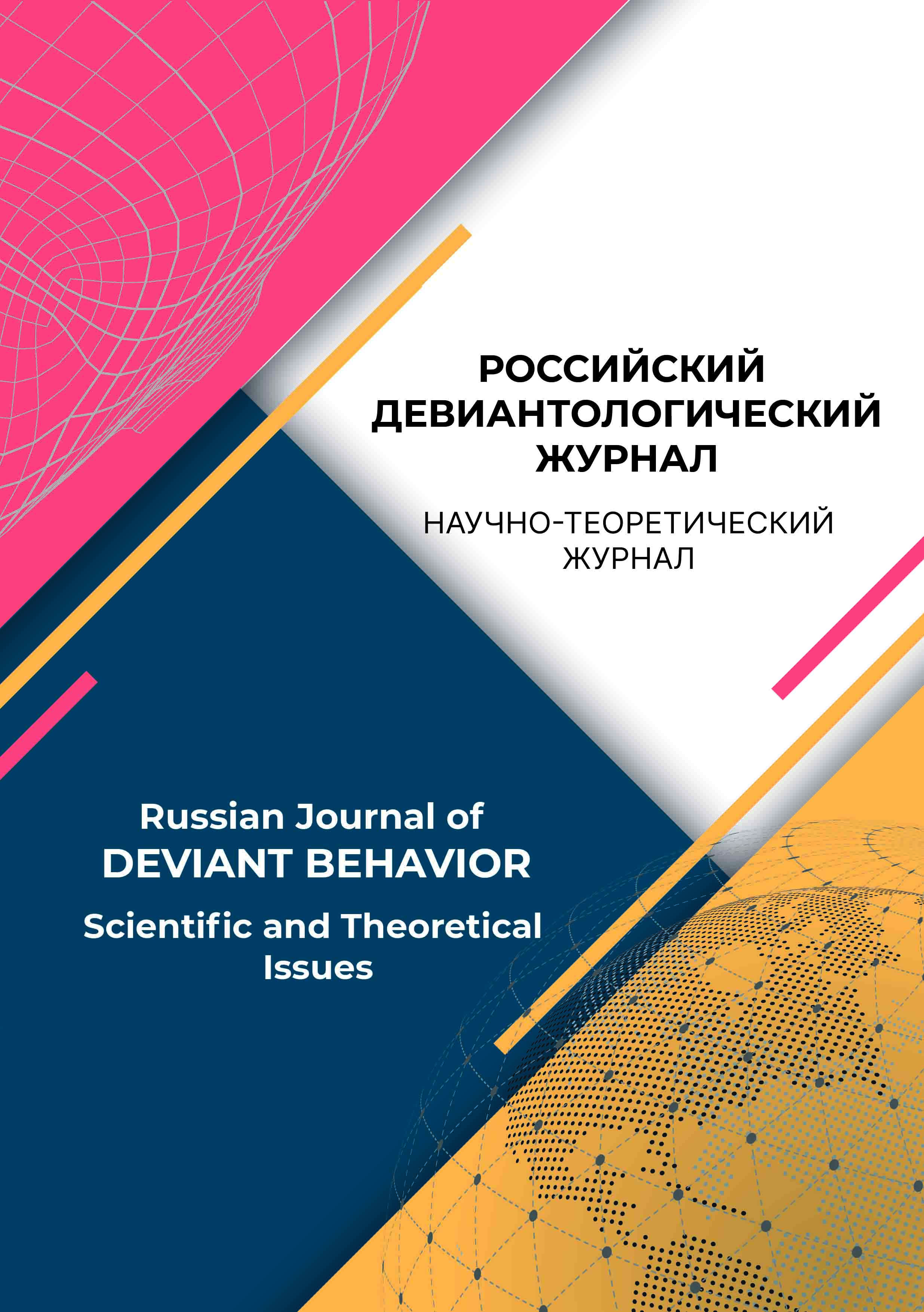Russian Federation
from 01.01.2020 to 01.01.2021
Russian Federation
UDC 15
The spread of gambling addiction is one of the serious problems of modern society. Gambling addiction is a progressive disorder which is a complex formation and includes a syndrome of mental and physical dependence. A person involved in gambling creates grounds for inevitable failure: social disadaptation, coldness to relatives and social alienation; loss of what has been achieved in life; risk of losing livelihood; suicidal attempts; criminal behavior, etc. The negative social consequences demonstrate the need for more effective and comprehensive study in this area. The peculiarities of transformation of the value -and- sense sphere of personality in developing game addiction as well as in the process of rehabilitation still remain an insufficiently explored issue. This determines the relevance of our work. Objective. The article is devoted to the peculiarities of transformation of the value-and-sense sphere of gamblers undergoing rehabilitation program. Methods. Participants were 42 gambling addicts undergoing a rehabilitation program at the branches of the rehabilitation center “XXX” (Odintsovo, Moscow region and Omsk). The survey packet consisted of Zimbardo Personality Time Perspective; Life-Purpose Orientation Test by D.A. Leontiev; Self-Attitude Questionnaire by V.V. Stolin and S.R. Panteleyev; Rokeach Value Survey and the personal data questionnaire. Statistical methods (primary descriptive statistics, correlation analysis, Fisher’s F-criterion, Student’s t-distribution and the Wilcoxon signed-rank test) were used to process data. Results. In the course of the study, the hypothesis of a possible transformation of the value-and-sense sphere of gamblers towards a more adaptive one in the conditions of rehabilitation was tested and confirmed. The study found a connection between participation in the rehabilitation program and changes in the time perspective of the participants’ positive future. The research also revealed an increase in the level of life meaningfulness and self-esteem and a decrease in the level of self-blaming. The tests showed the shift of value from material support to self-development and self-acceptance. Scientific novelty. It was for the first time when the researchers made an attempt to study and compare to a great extent the characteristics of the value-and-sense sphere of gamblers before and after rehabilitation. Practical significance. The results can be taken into account to plan treatment and rehabilitation measures as well as to prevent gambling addiction.
value-semantic sphere, game addiction, values, sense, self-esteem, time perspective, self-perception, rehabilitation
1. American Psychiatric Association DSM-III: Diagnostic and Statistical Manual of Mental Disorders (izd. 3). (1980). Washington, DC: American Psychiatric Association.
2. American Psychiatric Association. Diagnostic and statistical manual of mental disorders (izd. 5). (2013). Arlington: American Psychiatric Association.
3. Anderson, Ants, Sisask Merike, Värnik, Airi. (2011). Familicide and suicide in a case of gambling dependence. The Journal of Forensic Psychiatry & Psychology (22 (1)), 156−168.
4. Banks, James, Waters, Jaime, Andersson, Catrin, Olive, Victoria. (2019). Prevalence of Gambling Disorder Among Prisoners: A Systematic Review. International Journal of Offender Therapy and Comparative Criminology. https:// journals.sagepub.com/doi/full/10.1177/0306624X19862430
5. Beauregard, V. (2013). Gambling in Detention: A Source of Violence? Deviant Behavior. https://www.tandfonline.com/ doi/full/10.1080/01639625.2012.726178
6. Bennett, J. T. (2019). Inner gnawing, outward clawing - The role of existential crises in crime causation. Journal of Interpersonal Violence. https://doi.org/10.1016/j.avb.2018.11.004
7. Ciccarelli, M., Malinconico, R., Griffiths, M. D., Nigro, G., Cosenza, M. (2016). Reward preferences of pathological gam¬blers under conditions of uncertainty: An experimental study. Journal of Gambling Studies (32 (4)), 1175-1189.
8. Cosenza, M., Griffiths, M. D., Nigro, G., Ciccarelli, M. (2017). Risk-taking, delay discounting, and time perspective in adolescent gamblers: An experimental study. Journal of Gambling Studies (33 (2)), 383-395.
9. Dickerson, M. G. (2003). Gambling as an Addictive Behaviour: Impaired Control, Harm Minimisation, Treatment and Prevention (International Research Monographs in the Addictions). Cambridge, UK; New York: Cambridge University Press.
10. Dowling, Nicki A., Oldenhof, Erin, Cockman, Sue, Suomi, Aino, Merkouris, Stephanie S., Jackson, Alun C. (2019). Problem Gambling and Family Violence: Factors Associated With Family Violence Victimization and Perpetration in Treatment-Seeking Gamblers. Journal of Interpersonal Violence. https://journals.sagepub.com/doi/10.1177/0886260519835877
11. Hing, N., Russell, A. (2017a). How anticipated and experienced stigma can contribute to self-stigma: The case of problem gambling. Frontiers in Psychology (8), 235.
12. Hing, N., Russell, A. (2017b). Psychological factors, sociodemographic characteristics, and coping mechanisms associated with the self-stigma of problem gambling. Journal of Behavioral Addictions (6 (3)), 416-424.
13. Ho, K.-w. (2016). Risk Factors of Adolescent Pathological Gambling: Permissive Gambling Culture and Individual Factors. Deviant behavior. https://doi.org/10.1080/01639625.2016.1197031
14. Lahn, Julie (2005). Gambling Among Offenders: Results From an Australian Survey. International Journal of Offender Therapy and Comparative Criminology (49 (3)), 343-355. doihttps://doi.org/10.1177/0306624X04270790.
15. Langham, E., Thorne, H., Browne, M., Donaldson, P., Rose, J., Rockloff, M. (27 yanvarya 2016 g.). pubmed. Polucheno iz BMC Public Health: https://pubmed.ncbi.nlm.nih.gov/26818137/
16. Lelonek-Kuleta, Bernadeta, Bartczuk, Rafał. (2019). Problem gambling among male Polish prisoners: A study of prevalence and psychosocial factors. Australian and New Zealand Journal of Criminology (53 (2)). https://journals.sagepub.com/doi/full/10.1177/0004865819890379
17. Li, E., Browne, M., Rawat, V., Langham, E., Rockloff, M. (2017). Breaking bad: Comparing gambling harms among gamblers and affected others. Journal of Gambling Studies (33 (1)), 223-248.
18. Moreira, D., Pinto, M., Almeida, F., Barbosa, F. (2016). Time perception deficits in impulsivity disorders: A systematic review. Aggression and Violent Behavior.
19. Pontell, Henry N., Fang, Quan, Geis, Gilbert. (2014). Economic Crime and Casinos: China’s Wager on Macau. Asian Journal of Criminology (9 (1)). https://link.springer.com/article/10.1007/s11417-013-9168-0
20. Riley, Ben J., Larsen Amii, Battersby, Malcolm, Harvey, Peter. (2017). Problem Gambling Among Australian Male Prisoners: Lifetime Prevalence, Help-Seeking, and Association With Incarceration and Aboriginality. International Journal of Offender Therapy and Comparative Criminolog (62 (11)). https://doi.org/10.1177/0306624X17740557
21. Savard, Annie-Claude,Turcotte, Daniel, Tremblay, Joël. (2017). Problem Gambling in Adolescence: An Analysis Conducted from the Actor’s Perspective Deviant Behavior. Deviant Behavior Online first (5), 1-16. https://doi.org/10.1080/01639625.2017.1286177
22. Sleczka, Pawel, Braun-Michl, Barbara, Kraus, Ludwig . (2020). Gamblers’ attitudes towards money and their relationship to gambling disorder among young men. Journal of Behavioral Addictions (9 (3)), 744-755.
23. Williams, Robert J., Royston, Jennifer, Hagen, Brad F. (2005). Gambling and Problem Gambling Within Forensic Populations: A Review of the Literature. Criminal Justice and Behavior (32 (6)), 665-689.
24. Bogacheva, I. G. (2009). Teoreticheskiye podkhody k izucheniyu tsennostnosmyslovoy sfery lichnosti. Izvestiya Rossiyskogo gosudarstvennogo pedagogicheskogo universiteta im. A. I. Gertsena (98), 247-252.
25. Bratus’, B. (1988). Anomalii lichnosti. Moskow: Mysl’.
26. Buzik, O. (2008). dissertatsiya. «Zavisimost’ ot azartnykh igr: klinicheskiye proyavleniya, osobennosti techeniya, lecheniye», 264.
27. Volkova, Ye. A., Yegorov, A. YU. (2007). Lichnostnyye osobennosti gemblerov i narkozavisimykh. Narkologiya (4), 39-43.
28. Zeygarnik, B. (1986). Patopsikhologiya. Moskow: izd-vo Mosk. un-ta, 287.
29. Zimbardo, F., Boyd, Dzh. (2010). Paradoks vremeni. Novaya psikhologiya vremeni, kotoraya uluchshit vashu zhizn’. Saint Peterburg: Rech’, 352.
30. Komarova, L. E. (2007). Pochemu istinnyy igrok vsegda proigryvayet (nekotoryye soobrazheniya po povodu romana F. M. Dostoyevskogo «Igrok»). Moskovskiy psikhoterapevticheskiy zhurnal (2), 142-157.
31. Leont’yev, D. A., Mandrikova, Ye. YU., Osin, Ye. N., Plotnikova, A. V., Rasskazova, Ye. I. (2007). Opyt strukturnoy diagnostiki lichnostnogo potentsiala. Psikhologicheskaya diagnostika (1), 8-31.
32. Mendelevich, V. D. (2007). Rukovodstvo po addiktologii. Saint Petersburg: Rech’, 768.
33. Molchanova, Yu. Yu. (2010). Motivatsiya gemblera Moskovskiy nauchno-issledovatel’skiy institut psikhiatrii. Psikho-logicheskiye issledovaniya (3 (11)), 4.
34. Molchanova, Yu. Yu. (2010). Osobennosti cennostnyh orientacij pri gemblinge: tez. dokl. Moskow: «Medpraktika-M».
35. Seryy, A. V., Yanitskiy, M. S., Semenova, M. B. (2012). Transformatsiya tsennostno-smyslovoy sfery lichnosti v situatsii vynuzhdennoy poteri rabot. Psikhologiya v ekonomike i upravlenii (2), 38-43.
36. Stolin, V. (1983). Samosoznaniye lichnosti. Moskow: Izdatel’stvo MGU, 286.
37. Ugolovnyy kodeks Rossiyskoy Federatsii” ot 13.06.1996 N 63-FZ. (10 marta 2021 g.). Polucheno iz base.garant.ru: http:/base.garant.ru/12125267/6096ee730aa40fe9bf0f67866913a94b/
38. Khanzyan, E. (2007). Uyazvimost’ sfery samoregulyatsii u addiktivnykh bol’nykh: vozmozhnyye metody lecheniya. V S. Daulinga (Red.), Psikhologiya i lecheniye zavisimogo povedeniya (28-54). Moskow: Nezavisimaya firma «Klass».
39. Tsygankov, B. D., Malygin, V. L., Yegorov, A. YU., Khvostikov, G. S. (2007). Voprosy narkologii. Nekhimicheskiye addiktsii: patologicheskaya igrovaya zavisimost’, internet-zavisimost’, zavisimost’ ot komp’yuternykh igr (4), 18-38.














